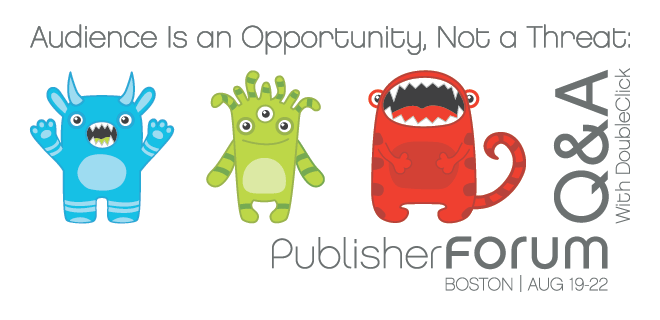
Yes, audience data is kind of a monster to most publishers, but it’s a friendly one, kind of like the wiseacres in Monsters, Inc. Really, you can’t be scared to embrace it. Before he explains the art of audience market navigation to the Boston PubForum audience, we caught up with DoubleClick Senior Product Manager Sean Harvey to hear his thoughts on audience, DNT and the latest developments for DFP.
What are publishers’ biggest misconceptions when it comes to audience?
Publishers too often see this term “audience” as a threat instead of an opportunity. It’s not. It’s all about delivering higher yields and better ads and content to your readers. That’s what publishers already do. Audience is a new opportunity to increase revenues that the most savvy publishers are taking advantage of now.
It’s true that as a publisher you need to treat your audience like an asset. But if your data is valuable enough to worry about it “leaking” to advertisers, it’s a sign that it has value to you as a business. Publishers, after all, are the ones who have the direct relationships with web consumers, and publishers have all manner of unique data that they have always used in the offline world – and the online world enables data to be used in the same way, just more efficiently and at bigger scale. The advent of mobile – which is less amenable to third party data technologies – makes the publisher’s first party data that much more valuable.
Are publishers freaking out about DNT? What questions are you most often asked, and what do you think publishers most need to understand?
It affects different publishers differently, but it is definitely something that all publishers should be thinking about. And they are. The publishers’ participation is an important component of the Do Not Track discussion and we encourage them to share their perspectives on privacy and security issues. We have and will continue to work with our publishers to develop innovative advertising technology solutions that promote transparency and choice.
What are publishers’ biggest challenges in enabling advertisers to reach audiences on a variety of devices?
The two big ones are obviously (1) the state of cookies on mobile devices and (2) the increasing device fragmentation of a given user across phone, tablet, laptop, work computer and soon online television box. Having logged-in relationships with users helps solve some of the complexities of managing a cross-device relationship with your users.
In July, DFP released the Teams functionality – can you explain this tool and how publishers can best exploit it?
Imagine that your organization operates an East and West coast sales team, and you’d like to restrict access to your East coast orders and advertisers so only users on your East coast team can view and edit the campaigns. With the new Teams functionality in DFP, you can now group your network’s users into teams, defined by you, enabling you to restrict access to any combination of companies, orders and inventory.
Now your network can more closely reflect your organization and operations. With teams, users see the advertisers, orders, and inventory that matters to them and nothing more, reducing noise and allowing users to sell and book more efficiently.
 |
Macro-level changes are coming, and you can sieze the opportunities that follow at OPS NY. This event will bring together digital advertising leaders and ops professionals to discuss a rapidly evolving landscape and develop strategies for monetization. Register today for OPS NY which will be held Oct. 4, 2012. |